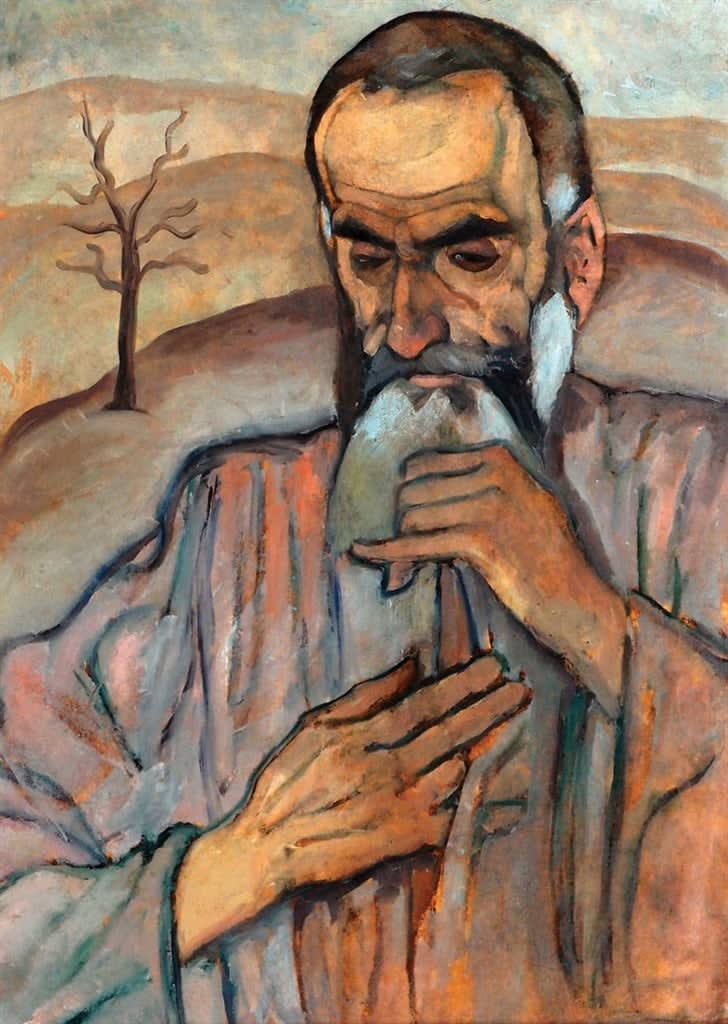
Reuven Rubin
The work is accompanied by a certificate of authenticity signed by Mrs. Carmela Rubin, Reuven Rubin Museum, Tel-Aviv
Reuven's painting of the Prophet belongs to a series of paintings of prophets and messiahs, which he painted in Bucharest and Chernowitz until 1922 when he was influenced by the symbolisms of Ferdinand Hodler, the Swiss painter, whom he also met in 1913. These were paintings full of pathos, theatrical poses, and an apocalyptic atmosphere, closely related to the expressive spirit of his contemporary, J.L. Peretz, and the paintings of the prophets painted by Jakob Steinhardt in Berlin as early as 1913-1912. The current painting was exhibited in 2006 at the Israel Museum in the exhibition "Prophet in His City: The Early Work of Reuven Rubin 1923-1914", Curator: Amitai Mendelson.
Mendelson described it:
"...the aged figure, seen in his cloak, with his long beard and dramatic gaze, appears as a biblical prophet. He is planted in a desert landscape with a solitary tree behind him. The serene confidence and wisdom expressed in his gaze contrast with the activity and pathos of the other paintings." (p. 36). The depiction of the prophet is based on the patriarchal figure of Galkatzion, a prominent intellectual (a lover of Israel) in early 20th-century Romania, whose name shone in Reuven's 1922 painting "Jesus and the Last Apostle" (Tel Aviv Museum Collection). The head of the prophet in this painting resembles that of "the Last Apostle," about which Reuven from Bucharest wrote to his Parisian friend, Bernard Weinberg: "... 'Jesus and his last apostle,' a painting 1.10X1, with Galkatzion serving as a model for the apostle..."
Reuven's art in those years fluctuates between Jewish spirituality of longing for infinite justice and Christian messianism full of suffering. His integration into the Yiddish-avant-garde circle of Chernowitz (Isaac Mangher, Eliezer Steinberg, Jacob Sternberg, Arthur Kolnik, and others) found expression in visionary, dramatic, and gothic character design. The prophet in his painting is solemn and composed, departing in this aspect from the predominantly "religious" spirit of his early paintings. The warm-brown tones and the drawing of the hands establish a connection to the figure of Isaiah the Winnower, the Viennese, while the leafless tree standing alone in the mountainous background symbolizes the prophet's loneliness, his sufferings since the mountain is a well-known romantic symbol of spiritual realization. The symbols of the withered tree and the hill often served Rubin during this harsh period.
In the year he painted "The Prophet," Rubin also wrote Symbolist poetry in Yiddish, which centered on himself as an artist with a religious-metaphysical mission. In another poem, Rubin wrote about the voices of God calling the messianic poet to walk, about desert landscapes, destruction, and longings for "a love that will ignite/ a holy fire/ on ancient altars/ built by the faithful of God." Not long after, Rubin read the book by the Scottish Romantic essayist, Thomas Carlyle, "On Heroes, Hero-Worship, and the Heroic in History", where the idea of the hero as a prophet and poet is captured. In 1922, Rubin wrote: "...my desire is only to express the idea of the supreme being. I plead God, the new God, to end human suffering...". "The Prophet" painting is an exceedingly rare work for collectors with a profound insight into Rubin's work. - Gideon Ofrat
Exhibitions
Zemack Gallery, Tel Aviv, Israel | Zemack’s 3rd Birthday Celebration with Israeli Classics | January 2014 - February 2014.Israel Museum | "The Prophet in His City: The Early Works of Reuven Rubin 1923-1914" | November 2006 - June 2007.